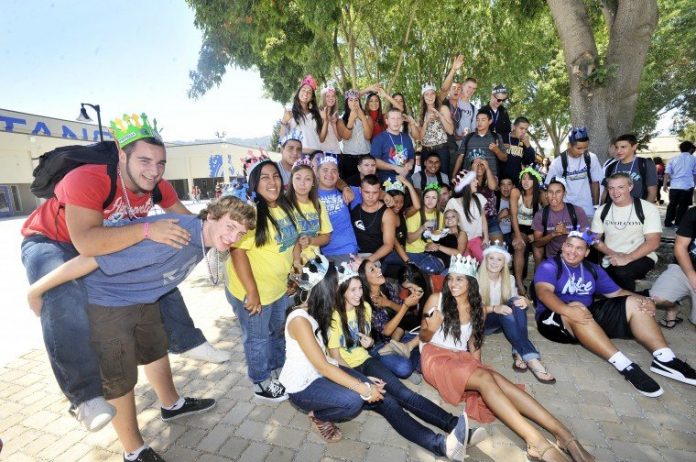
With the average college graduate buried beneath $25,000 in student loans in an economy darkened by rampant unemployment, pricey tuition rates elicit cynical farce from humor writers like Jarod Kintz, who scoffed, “I wouldn’t advise making a four-year commitment to eventually land an $8 an hour job.”
This sentiment – one felt nationally in a climate where the collective student loan burden is $1 trillion – is none the weaker in Gilroy.
“They have loads of debt and they’re working at Starbucks,” said Gilroy High School Principal Marco Sanchez. “You’ve got an over-qualified person who’s asking you what kind of latte you want. It’s a flooded job market with limited opportunities, and students see that. They’re asking, why should I saddle myself with a mortgage issue for the rest of my life and I can’t even pay it?”
Gilroy Unified School District staff studied this reality during a recent Aug. 16 school board meeting, which revealed 25 percent and 27 percent of 2012 Gilroy and Christopher high school graduates will attend a four-year college. Finance and cost are the number one reasons listed by students for not enrolling at a four-year institution, according to district data.
For GHS, that rate is down 4 percent from the last two years. CHS opened three years ago and saw its first group of seniors graduate in June, so there is no data prior to the class of 2012.
Statistics also show the number of GUSD students planning to attend a two-year school has increased substantially over the previous four years. Approximately 31 percent of Gavilan students are transferring to four-year universities.
“That’s a small percentage that’s going to end up getting that bachelor’s degree,” observed Trustee Fred Tovar. “That’s a little alarming to me.”
That 31 percent only accounts for students transferring to California State University or University of California schools, according Gavilan College President Steve Kinsella. The largest number of students attending Gavilan “don’t have any plans of transferring,” he added.
People with a bachelor’s degree make 84 percent more over a lifetime than high school graduates, according to a study released in 2011 by Georgetown University.
As tuition fees surged almost 130 percent over the last 20 years according to the College Board, a nonprofit organization aimed at connecting students to college success and opportunity, the quintessential four-year college experience is a luxury less and less families can afford.
College Board statistics point out that tuition has “risen rapidly” in recent years at an annual rate of 5.6 percent beyond general inflation, dissuading more parents from steering their children toward pricey CSU’s (which cost about $21,000 annually) or UC schools ($28,000 annually).
The changing culture has local educators talking about bolstering the district’s communication with parents insofar as financial solutions, in addition to encouraging more students to consider prestigious private institutions. In some instances, private colleges can end up being less expensive than UC or state schools.
“We have to do a better job with the parent education, especially with the cost,” said CHS Principal John Perales. “They don’t understand that private schools may be cheaper.”
Schools vs. parents: Students are getting mixed signals
GUSD principals and administrative staff are confident the district is already fostering a culture where “college is the expectation.”
When it comes to student attendance at four-year universities, however, several core groups are “falling through the cracks.”
This includes students who (1) applied to college but didn’t attend for financial reasons, (2) are not supported in their collegiate aspirations by their families, or (3) are qualified to apply, but didn’t because they can’t afford it, or think their family won’t be able to support them.
The hard truth, as explained by Perales and Sanchez, is that Gilroy teens are getting conflicting messages.
While GUSD strives to make college “the vision and goal for all of our students,” district staff say highschoolers are getting steered in alternative directions by parents who can’t assume the financial burden.
CHS Academic Coordinator Marah Kuwada understands this dichotomy.
As a parent who makes a good living and has a master’s degree, “I don’t know that I’m going to be able to send my son where he wants to go to college next year,” said Kuwada, who used her personal situation as an example while presenting to trustees during the Aug. 16 meeting.
Middle-class families who don’t qualify for significant financial aid, she continued, “are the people that are falling through the cracks … I could fill out the FAFSA (Free Application for Federal Student Aid) and if he’s lucky, his loans will be subsidized.”
It’s a frustrating reality for high school principals, whose overarching mission of equipping students for success in college is undermined by financial setbacks at home.
“I was flabbergasted when some of our top students would come to me and say, ‘I’m not going to apply for a four-year,’” said Perales. “The pressure coming from home – even to the point where some could not afford the application fee – was alarming and it was saddening. We’re pushing them, firing them up … showing them the road to a four-year school, yet when they go home they’re getting a different message. And it’s one that I have absolutely no control over.”
While district staff agrees this is a culture they can better address, trustees also want to steer clear of a “one size fits all” mentality.
GUSD Board President Tom Bundros says the district strikes a healthy balance in helping students weigh and explore their post-high school paths.
“I don’t support pushing students into four-year colleges, nor do I take the information presented tonight as an indication of a gap we need to close,” said Bundros. “The messaging I see coming from the district is at the right level. I wouldn’t want us to see bias more in the other direction. We would be driving some unintended consequences, including setting expectations for our students that are at odds with expectations of their parents. We’re on the right path and I wouldn’t want see it change. “
Branching from this concern, Trustee Pat Midtgaard took care to point out that four-year universities aren’t necessarily the superior route.
With colleges pumping out graduates with degrees in broad subjects such as business or liberal arts, graduates can become “one-trick ponies … that’s what’s happening with a lot of people,” said Midtgaard, who underscored the critical importance of trade schools that prepare students for careers in technical fields.
Trustees and district staff will continue to explore what can be done to strengthen Gilroy student graduation rates from four-year universities, in addition to upping the number of transfers from Gavilan College to four-year universities. Keeping parents involved and informed is a key variable, educators agree.
As the “college dream a lot of times gets shattered in (students’) junior year, I think we have to do a better job of bringing the parents on board early,” said Perales.
Percentage of Gilroy Unified School District graduates attending post-secondary institutions in 2011-12
• Four year: 25 percent (GHS), 27 percent (CHS), 75 percent (GECA)
• Two year: 57 percent (GHS), 58 percent (CHS), 16 percent (GECA)
• Tech/other: 4 percent (GHS), 1 percent (CHS), 1 percent (GECA)
Key: Gilroy High School (GHS), Christopher High School (CHS), Dr. TJ Owens Early College Academy (GECA)












